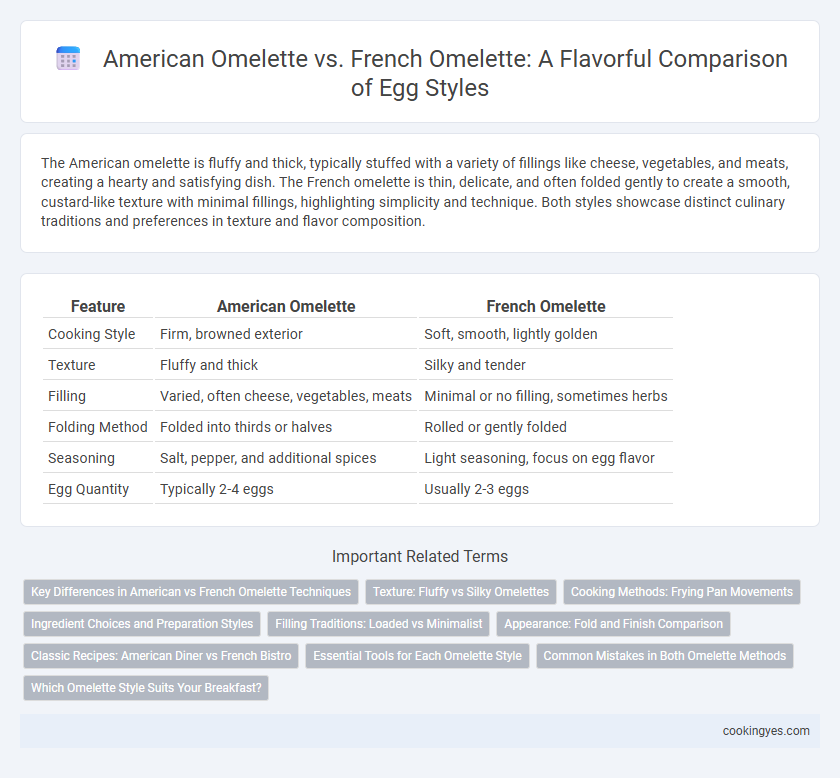The American omelette is fluffy and thick, typically stuffed with a variety of fillings like cheese, vegetables, and meats, creating a hearty and satisfying dish. The French omelette is thin, delicate, and often folded gently to create a smooth, custard-like texture with minimal fillings, highlighting simplicity and technique. Both styles showcase distinct culinary traditions and preferences in texture and flavor composition.
Table of Comparison
| Feature | American Omelette | French Omelette |
|---|---|---|
| Cooking Style | Firm, browned exterior | Soft, smooth, lightly golden |
| Texture | Fluffy and thick | Silky and tender |
| Filling | Varied, often cheese, vegetables, meats | Minimal or no filling, sometimes herbs |
| Folding Method | Folded into thirds or halves | Rolled or gently folded |
| Seasoning | Salt, pepper, and additional spices | Light seasoning, focus on egg flavor |
| Egg Quantity | Typically 2-4 eggs | Usually 2-3 eggs |
Key Differences in American vs French Omelette Techniques
The American omelette is typically cooked at a higher heat, resulting in a firmer texture and fully cooked interior, often filled generously with ingredients before folding. In contrast, the French omelette is cooked over lower heat with constant stirring, producing a soft, creamy interior with no browning and usually filled after folding. French technique emphasizes smooth, delicate curds and a slightly runny center, while the American style prioritizes a fluffy, well-set egg base.
Texture: Fluffy vs Silky Omelettes
American omelettes are characterized by a fluffy texture achieved through whipping eggs to incorporate air before cooking, creating a light and airy bite. French omelettes are known for their silky, smooth texture, formed by gently cooking beaten eggs over low heat and carefully folding them to avoid browning. The contrast in texture highlights the American style's volume versus the French style's delicate creaminess.
Cooking Methods: Frying Pan Movements
The American omelette relies on vigorous stirring and folding in the frying pan, creating a fluffy texture with visible fillings. The French omelette requires gentle swirling and smooth wrist movements to cook evenly without browning, producing a delicate, silky surface. Mastering these distinct pan techniques is essential for achieving authentic omelette styles.
Ingredient Choices and Preparation Styles
American omelettes typically incorporate a variety of fillings such as cheese, vegetables, and meats, resulting in a heartier and more textured dish, while French omelettes emphasize simplicity with fewer ingredients like herbs and a single type of cheese for a delicate flavor. The preparation style for American omelettes involves cooking the eggs until fully set and folding them over the fillings, creating a thicker, fluffier texture. In contrast, French omelettes are cooked quickly over medium heat, often stirred continuously to achieve a smooth, creamy interior with a lightly golden, tender exterior.
Filling Traditions: Loaded vs Minimalist
American omelettes embrace a loaded filling tradition, often packed with ingredients such as cheese, ham, mushrooms, bell peppers, and onions, creating a hearty, flavor-packed dish. In contrast, French omelettes emphasize minimalism with a smooth, silky texture and a simple filling, typically limited to fine herbs, cheese, or a single ingredient, highlighting delicate taste and technique. This contrast reflects cultural preferences where American omelettes prioritize abundant, varied fillings, while French omelettes showcase subtlety and culinary finesse.
Appearance: Fold and Finish Comparison
American omelettes typically feature a thick, fluffy texture with a visibly folded, layered structure, often slightly browned on the outside for a hearty appearance. French omelettes display a smooth, silky surface with a delicate, soft exterior, folded tightly into a sleek, cylindrical shape, showcasing minimal browning. The distinctive finish of the French omelette emphasizes elegance and uniformity, contrasting with the American version's robust and rustic presentation.
Classic Recipes: American Diner vs French Bistro
American diner omelettes feature a fluffy, folded egg base filled with hearty ingredients such as cheese, ham, bell peppers, and onions, reflecting a robust and customizable style. French bistro omelettes emphasize a delicate, silky texture achieved by gently cooking beaten eggs and folding them with minimalist fillings like fine herbs or melted Gruyere, showcasing refinement and simplicity. Classic American recipes prioritize volume and bold flavors, while French versions focus on technique and subtlety in both taste and presentation.
Essential Tools for Each Omelette Style
Essential tools for American omelettes include a non-stick skillet, a sturdy spatula, and a whisk for beating eggs thoroughly, ensuring a fluffy texture. For French omelettes, a smaller, rounded non-stick pan and a fork or silicone spatula are preferred to create a smooth, tender surface with precise folding. High-quality butter is essential in both styles for flavor and preventing sticking during cooking.
Common Mistakes in Both Omelette Methods
Overcooking remains a frequent error in both American and French omelette styles, resulting in rubbery texture rather than a tender, creamy finish typical of a perfect French omelette or the fluffy texture desired in an American one. Another common mistake is improper heat management; using too high a temperature causes uneven cooking and browning, particularly problematic in the delicate French omelette method. Lastly, failing to incorporate air by over-stirring or under-beating eggs affects the volume and lightness, crucial in achieving the characteristic fluffiness of an American omelette and the soft curds in a French variety.
Which Omelette Style Suits Your Breakfast?
American omelettes are fluffy, packed with fillings like cheese, vegetables, and meats, offering a hearty breakfast option rich in protein and nutrients. French omelettes have a smooth, tender texture with minimal fillings, typically herbs or cheese, providing a light, elegant dish that highlights egg flavor. Choose an American omelette for a filling, customizable meal or a French omelette for a delicate, gourmet breakfast experience.
American vs French omelette for omelette style Infographic

 cookingyes.com
cookingyes.com